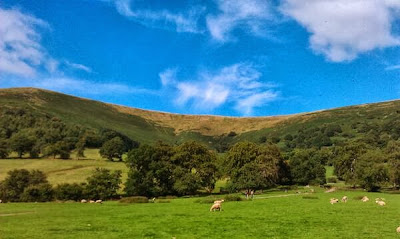I have succumbed to the urge for reflective list-making that the end of the
year brings. Here are ten works and discoveries, all loosely related to landscape and sense of place, that, for whatever reason, I have found interesting during 2013; following up on last years midwinter hand-list.

All hail the new psychedelic puritans
My favourite film of the year was undoubtedly Ben Wheatley's A Field In England; a study of hallucinogens, esoteric knowledge and seeking out an inn during the English Civil War. Set entirely in a field (in Monmouthshire as it happens) and imaginatively shot in black and white, this is a film that benefits from repeat viewings to reveal its layered narrative.

The final harvest home
Jim Crace's final novel, Harvest, was favourite to win the 2013 Man Booker prize but in the event was pipped at the post. However, I thoroughly enjoyed this slowly rhythmic hymnal to the dying days of an unnamed remote village, as its communal fields are on the verge of transformation by forcible enclosure.

An essay on the everyday other worldliness of the Essex landscape
I reviewed The New English Landscape recently for the Caught By The River web site. This is a thoughtfully persuasive reflection by Ken Worpole and Jason Orton on the eastward shift of ideas, art and writing on ecology and landscape to envelop not just a previously neglected region, Essex and East Anglia, but also changing perceptions of what constitutes places worthy of comment and study.
A folk horror discovery
More from the endless BFI archive: Robin Redbreast is a BBC Play for Today broadcast in 1970, the themes of which - outsider entering an insular rural community, eccentric folk rituals morphing into dread and horror - foreshadowed those of The Wicker Man. The latter has of course become a perhaps overexposed cult classic, the former is a real gem that I had not even heard of until a few months ago (thank you Twitter!).
Lonesome Dreams by Lord Huron, a 'folk-rock Thoreau', was an album that timelessly evoked the big skies and horizons of America and sound-tracked my summer reading of Cormac McCarthy's bleakly magnificent Blood Meridian.

A trespass way: unbounded freedom ruled the wandering scene
This was a subversively enjoyable exercise in pedestrian disobedience over nine miles of the southern Cotswolds avoiding public rights of way, as described in a Landscapism blog post earlier this year.
'The oaks, the rivers, the stones, those things that laugh last'
'Always, always, always the sea'
Yet another fine release by the BFI, From the Sea to the Land Beyond brought together a collage of archive footage, largely from the first half of the twentieth century, chronicling life on Britain's coastline: shipyards, seaside towns, fishing fleets and coastal topography. British Sea Power provide the accompanying soundtrack, now released in its own right.
Severn crossings of the River Severn
A watery theme also for a favourite day of landscape discovery, exploring the estuarine topography and foreshore archaeology associated with crossings of the lower River Severn, including the melancholy delight of the boat graveyard at Purton.
The Full English
The English Folk Dance and Song Society (EFDSS) launched The Full English this year, a fascinatingly comprehensive digital archive of early 20th century manuscripts of folk songs, tunes and dances.























.jpg)
.jpg)














